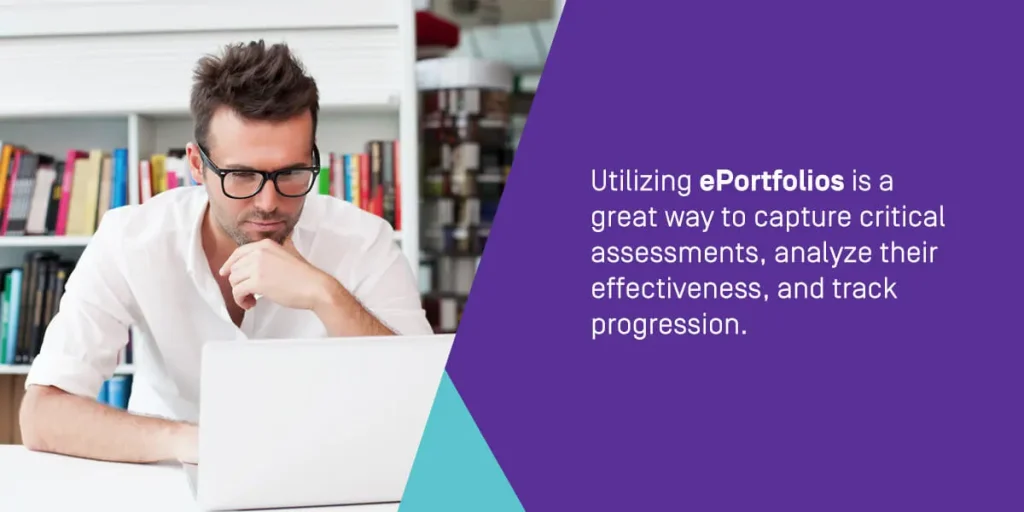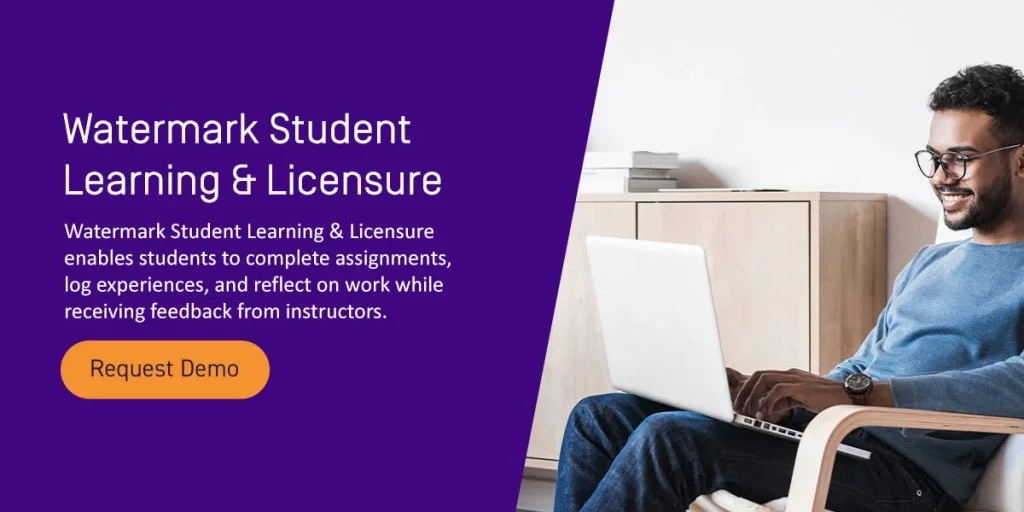



Course evaluations and ePortfolios are separate things — but what if they could be used together for maximum impact? Assessment surveys allow students the opportunity to evaluate the efficiency and value of your courses. These course evaluations can be reference points for well-received topics or most-remembered assignments and give educators the chance to see how well learners are doing. They are an indirect assessment meant to be used as aggregate, anonymized reflection.
By contrast, the ePortfolio — a collection of a student’s work that might include a combination of writing samples, class projects, recommendations, analyses, art, or other exemplary work — is a direct and individualized assessment of learning. It showcases skills and creativity while also demonstrating valuable takeaways from courses.
Although distinct forms of assessment, these methods and tools, when used simultaneously, can provide a more complete picture of the student experience. Having students create and maintain ePortfolios: 1) helps mitigate some of the factors that cause bias in course evaluations by providing tangible examples of the learning that has taken place over time and 2) offers an additional data set (beyond evaluation responses) for educators to glean takeaways about their course effectiveness.
Read on to learn some benefits of supplementing end-of-semester student feedback surveys with ePortfolios.
End-of-semester or course assessments should be honest reflections of your institution. The accuracy and validity of student responses are vital to collecting quality data that can shape decisions about departments, classes, instructors, and more.
However, surveys are subject to cognitive bias and are not always comprehensive reflections of students’ thoughts and opinions. Poorly constructed or vague questions can lead students to give answers that aren’t accurate depictions of their experiences. The nature of these assessments — being that they take place at the end of a course — can also result in certain cognitive distortions that impact the quality of feedback.
Cognitive bias plays a part in our decisions, even when we’re unaware of it. Due to the mental shortcuts our brains create, bias affects our memory and retention and can impact survey and assessment answers. Recognizing that bias exists is the first step in understanding how to avoid it in course evaluation responses.
One of the most common forms of response bias is recency bias. The traditional end-of-the-semester assessments may be based on only the most recent — rather than the most significant — events. Asking students to recall an event will likely lead to responses about the last several weeks rather than a reflection of the entire semester because that’s what is freshest in their minds.
You may also encounter:
Although bias will always exist, there are ways to reduce its presence in evaluation surveys.
Creating open-ended response questions allows students to provide answers they can’t simply select, giving them the opportunity to offer more precise answers. Make sure the questions and instructions are straightforward. Asking multiple questions simultaneously can confuse students, and their answers won’t reflect their honest opinions. It’s also more likely they will ignore one or more of the questions if questions are grouped together.
Instead of creating order-based questions that correspond with the chronological timeline of events, use a variety of scattered questions. Even though you might not perceive or intend a connection between two questions when building a survey, the student may infer something from the order or mentally associate the questions and subconsciously allow their answer to one question to affect the next.
The questions you compose should be written in neutral language wherever possible. When students feel they’re agreeing with or evaluating a person rather than a course, their answers are more biased. Removing questions involving a scale or highlighting another person’s feelings will improve the likelihood of unbiased responses.
Although you can reduce bias, you can’t eliminate it entirely. Always remember that bias will exist, but you can find common themes in responses and determine how your institution will employ feedback from evaluation surveys accordingly. For example, courses requiring a smaller workload tend to receive more positive feedback, even if the information is not as beneficial as in other classes. Determining where the bias lies in feedback is crucial when determining what is and isn’t valuable to students and the institutions that serve them.
You may primarily view ePortfolios as a student-centric tool housing evidence of their completed work to show future employers, interviewers, or collaborators. But they can provide benefits beyond this — like signaling and guiding improvements to courses and instruction. Reviewing the results of ePortfolio assessments regularly, like at the end of each term, can augment your understanding of student learning experiences and give you additional insights to pair with course evaluation results when the time comes to take action to improve.
The more data you have, the more conclusive your results will be. Rather than choosing one process over another, make use of many. Taking advantage of both surveys and ePortfolios allows you to evaluate the student experience comprehensively.

Utilizing ePortfolios is a great way to capture critical assessments, analyze their effectiveness, and track progression. Educators can track progression and log observations easily to note student engagement, comprehension, enjoyment, and more to evaluate course effectiveness. An ePortfolio end-of-term review provides students with a way to reacquaint themselves with their work and allows instructors to determine significant takeaways.
Student benefits of ePortfolios include:
Of course, ePortfolios are no replacement for the scale and scope of surveys that can help you go beyond the classroom and drill down into areas of campus life that need improvements such as spending, public relations, available activities, and safety regulations. You can use Watermark Course Evaluations & Surveys to obtain feedback and receive actionable steps based on those responses. This software lets you monitor trends over time and quickly distribute results to other administrators and faculty. Institutions can use student surveys and ePortfolios together for an end-of-semester assessment to determine what elements are working well and where there’s room for improvement.

Watermark has over 25 years of industry knowledge and experience. We provide solutions that offer a wide range of functionality and give you the means to collect, manage, and measure data to streamline institutional efforts. We strive to develop solutions that higher education institutions can use to make significant improvements.
Watermark Student Learning & Licensure engages students and their instructors in deeper reflection on their skills, knowledge, and achievement of learning outcomes. The ePortfolio format brings assignments, field experiences, and feedback from instructors together so students can showcase their work and achievements to propel their progress in their program and present their credentials to employers. Administratively, our ePortfolios aim to improve higher education programs by letting institutions collect data over time and store it for further analysis.
Request a demo of Student Learning & Licensure to learn more about what our software can do to improve your institution.





























































































































































































































































































































































































